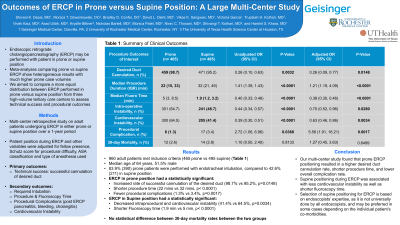Tuesday Poster Session
Category: Interventional Endoscopy
P3705 - Outcomes of ERCP in Prone versus Supine Position: A Large Multi-center Study
Tuesday, October 24, 2023
10:30 AM - 4:00 PM PT
Location: Exhibit Hall

Has Audio

Shivani K. Desai, MD
Geisinger Medical Center
Danville, PA
Presenting Author(s)
Award: Presidential Poster Award
Shivani K. Desai, MD1, Monica Dzwonkowski, DO1, Bradley D. Confer, DO1, David L. Diehl, MD1, Vikas Kumar. Sangwan, MD1, Victoria Garcia, PhD1, Krystle Bittner, MPH2, Truptesh Kothari, MD2, Vivek Kaul, MD, FACG2, Asad Ullah, MD3, Nicholas Bartell, MD3, Monica Patel, MD3, Nirav Thosani, MD4, Shivangi Kothari, MD2, Harshit S. Khara, MD1
1Geisinger Medical Center, Danville, PA; 2University of Rochester, Rochester, NY; 3University of Rochester Medical Center, Rochester, NY; 4McGovern Medical School at UTHealth, Houston, TX
Introduction: Endoscopic retrograde cholangiopancreatography (ERCP) may be performed with the patient in either prone or supine position. Meta-analyses comparing ERCP in prone versus supine position show heterogeneous results, possibly skewed due to higher prone case volumes. Our study aimed to compare a more equal distribution between ERCP performed in prone versus supine position from multi-center high volume tertiary care centers to assess technical success and procedural outcomes.
Methods: We performed a multi-center retrospective study on all adult consecutive patients undergoing ERCP in either prone or supine position over a 1-year period. IRB was approval was obtained. Demographics and procedural data were collected via manual chart review. Patient position during ERCP and other variables were adjusted for fellow presence, Schutz score for procedural difficulty, ASA classification and type of anesthesia used. Odds ratios (OR) and 95% confidence intervals (95% CI) pertaining to patient position during ERCP were reported from binary logistic regression models. All analyses were performed using SAS 9.4.
Results: A total of 960 adult patients met our inclusion criteria, of which there were 465 prone and 495 supine patients, with median age of 64 years, and 51.5% were male. A majority of ERCPs in prone position 83.9% were performed with endotracheal intubation, compared to 42.6% in supine position.
ERCP in prone position had a statistically significant higher rate of successful cannulation of the desired duct (98.7% vs 95.2%), shorter procedure time (22 mins vs 32 mins), but longer fluoroscopy time (5 mins vs 1.9 mins) compared to ERCP in supine position. (Table 1)
Prone patients were less likely to experience a procedural complication (1.3% vs 3.4%) but were more likely to have intraprocedural cardiovascular instability (64.5% vs 41.4%) compared to supine patients. There was no statistical difference between 30-day mortality rates between the two groups. (Table 1)
Discussion: The debate between prone versus supine patient positioning for ERCP is ongoing. Our multi-center study suggests that prone positioning during ERCP has higher desired duct cannulation rate, shorter procedure time and lower complication rate; however, with higher patient risk for intraprocedural cardiovascular instability and longer fluoroscopy time, as compared to supine positioning. The final determination of patient positioning should be individualized to each patient’s comorbidities and the endoscopists’ expertise.
Disclosures:
Shivani K. Desai, MD1, Monica Dzwonkowski, DO1, Bradley D. Confer, DO1, David L. Diehl, MD1, Vikas Kumar. Sangwan, MD1, Victoria Garcia, PhD1, Krystle Bittner, MPH2, Truptesh Kothari, MD2, Vivek Kaul, MD, FACG2, Asad Ullah, MD3, Nicholas Bartell, MD3, Monica Patel, MD3, Nirav Thosani, MD4, Shivangi Kothari, MD2, Harshit S. Khara, MD1. P3705 - Outcomes of ERCP in Prone versus Supine Position: A Large Multi-center Study, ACG 2023 Annual Scientific Meeting Abstracts. Vancouver, BC, Canada: American College of Gastroenterology.
Shivani K. Desai, MD1, Monica Dzwonkowski, DO1, Bradley D. Confer, DO1, David L. Diehl, MD1, Vikas Kumar. Sangwan, MD1, Victoria Garcia, PhD1, Krystle Bittner, MPH2, Truptesh Kothari, MD2, Vivek Kaul, MD, FACG2, Asad Ullah, MD3, Nicholas Bartell, MD3, Monica Patel, MD3, Nirav Thosani, MD4, Shivangi Kothari, MD2, Harshit S. Khara, MD1
1Geisinger Medical Center, Danville, PA; 2University of Rochester, Rochester, NY; 3University of Rochester Medical Center, Rochester, NY; 4McGovern Medical School at UTHealth, Houston, TX
Introduction: Endoscopic retrograde cholangiopancreatography (ERCP) may be performed with the patient in either prone or supine position. Meta-analyses comparing ERCP in prone versus supine position show heterogeneous results, possibly skewed due to higher prone case volumes. Our study aimed to compare a more equal distribution between ERCP performed in prone versus supine position from multi-center high volume tertiary care centers to assess technical success and procedural outcomes.
Methods: We performed a multi-center retrospective study on all adult consecutive patients undergoing ERCP in either prone or supine position over a 1-year period. IRB was approval was obtained. Demographics and procedural data were collected via manual chart review. Patient position during ERCP and other variables were adjusted for fellow presence, Schutz score for procedural difficulty, ASA classification and type of anesthesia used. Odds ratios (OR) and 95% confidence intervals (95% CI) pertaining to patient position during ERCP were reported from binary logistic regression models. All analyses were performed using SAS 9.4.
Results: A total of 960 adult patients met our inclusion criteria, of which there were 465 prone and 495 supine patients, with median age of 64 years, and 51.5% were male. A majority of ERCPs in prone position 83.9% were performed with endotracheal intubation, compared to 42.6% in supine position.
ERCP in prone position had a statistically significant higher rate of successful cannulation of the desired duct (98.7% vs 95.2%), shorter procedure time (22 mins vs 32 mins), but longer fluoroscopy time (5 mins vs 1.9 mins) compared to ERCP in supine position. (Table 1)
Prone patients were less likely to experience a procedural complication (1.3% vs 3.4%) but were more likely to have intraprocedural cardiovascular instability (64.5% vs 41.4%) compared to supine patients. There was no statistical difference between 30-day mortality rates between the two groups. (Table 1)
Discussion: The debate between prone versus supine patient positioning for ERCP is ongoing. Our multi-center study suggests that prone positioning during ERCP has higher desired duct cannulation rate, shorter procedure time and lower complication rate; however, with higher patient risk for intraprocedural cardiovascular instability and longer fluoroscopy time, as compared to supine positioning. The final determination of patient positioning should be individualized to each patient’s comorbidities and the endoscopists’ expertise.
Disclosures:
Shivani Desai indicated no relevant financial relationships.
Monica Dzwonkowski indicated no relevant financial relationships.
Bradley Confer: Boston Scientific Corporation – Consultant.
David Diehl: Boston Scientific – Consultant. Castle – Consultant. Laborie – Consultant. Merit Endotek – Consultant. Microtech – Consultant. Olympus – Consultant. OnePass Medical – Consultant. Pentax – Consultant. Steris – Consultant.
Vikas Sangwan indicated no relevant financial relationships.
Victoria Garcia indicated no relevant financial relationships.
Krystle Bittner indicated no relevant financial relationships.
Truptesh Kothari indicated no relevant financial relationships.
Vivek Kaul: CASTLE BIOSCIENCES – Consultant. CDX DIAGNOSTICS – Consultant. COOK MEDICAL – Consultant. MOTUS GI – Consultant. STERIS – Consultant.
Asad Ullah indicated no relevant financial relationships.
Nicholas Bartell indicated no relevant financial relationships.
Monica Patel indicated no relevant financial relationships.
Nirav Thosani: Abbvie – Consultant. Boston Scientific Corp – Consultant. Pentax America – Consultant. ROSEAID inc – Creatorship rights.
Shivangi Kothari: Boston scientific – Consultant. Castle Biosciences – Advisory Committee/Board Member. Olympus – Consultant.
Harshit Khara: Boston Scientific – Consultant, Speakers Bureau. Castle Biosciences – Consultant, Speakers Bureau. ConMed – Consultant, Speakers Bureau. Cook Medical – Consultant, Speakers Bureau. Medtronic – Consultant, Speakers Bureau. Olympus America – Consultant, Speakers Bureau. Pentax – Consultant, Speakers Bureau.
Shivani K. Desai, MD1, Monica Dzwonkowski, DO1, Bradley D. Confer, DO1, David L. Diehl, MD1, Vikas Kumar. Sangwan, MD1, Victoria Garcia, PhD1, Krystle Bittner, MPH2, Truptesh Kothari, MD2, Vivek Kaul, MD, FACG2, Asad Ullah, MD3, Nicholas Bartell, MD3, Monica Patel, MD3, Nirav Thosani, MD4, Shivangi Kothari, MD2, Harshit S. Khara, MD1. P3705 - Outcomes of ERCP in Prone versus Supine Position: A Large Multi-center Study, ACG 2023 Annual Scientific Meeting Abstracts. Vancouver, BC, Canada: American College of Gastroenterology.


